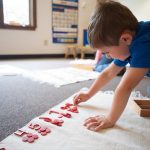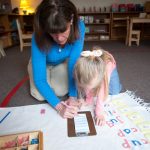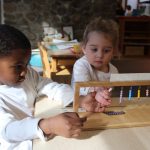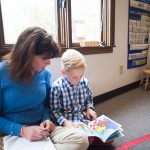Ages 3 – 6
Ages 3 – 6
- 4 or 5 day programs available to children ages 3-4
- Monday through Friday 8:20 a.m. – 11:30 a.m. or 8:20 a.m. – 3:00 p.m.
- After School care is available until 5:30 p.m.
- Kindergarten 5 day program
Our Primary environment is a three-year program dedicated to nurturing the children’s inherent curiosity by enabling them to explore and discover. At Fraser Woods Montessori School, children learn through touch and motion and by observing and doing. Academics are introduced through manipulative materials, laying the groundwork for abstract thinking. Classroom materials are joyfully presented and designed to stimulate the children’s senses as well as respond to their need for order and a sense of mastery within their world. Children at this level will experience intense periods of change, both cognitively and socially. The teacher, always observant, responds with appropriate lessons to support each child’s individual growth and capabilities.
Primary and Kindergarten Curriculum
Through collaborative learning, children in our Primary program learn skills for practical life. These include refinement of the senses, language, and mathematics, and hands-on opportunities in areas ranging from physical science to history. This unique approach allows children to develop skills that will foster success throughout their academic life.
Primary Social-Emotional Learning
In the Primary, FWM children learn to initiate a chosen activity, carry it out to their satisfaction, and put it away in preparation for the next child.
Our classrooms are communities where children practice the arts of grace, courtesy, and authentic communication. They learn to control themselves in group situations, and with guidance from their teachers, they learn to use conflict resolution skills to stand up for themselves, and what they believe.
Primary Language
Three to six-year-olds are in what Dr. Montessori called a “sensitive period” for language acquisition.
Three to six-year-olds delight in conversation. They begin to associate sounds, symbols, and meaning, the foundation of both reading and writing. Our classrooms surround children with language experiences. We provide a balanced literacy program in which informal conversations enrich more formal discussions, and interactive “read-aloud” sessions.
At FWM, children learn to read by writing words and stories using a moveable alphabet of cutout letters. Because children’s mental language abilities develop before their manual ability to form letters, they are encouraged to manipulate these symbols before putting pencil to paper to form letters and words. Children enthusiastically practice phonics skills as they sort attractive objects according to their component sounds, and they experience the thrill of decoding their first books. Reading is a natural outgrowth of mental writing activities, and children often seem to “explode” into reading, a joyful and identifiable moment for child, parent and teacher.
FWM Primary teachers read to children frequently to help them develop sequencing and conceptualization skills toward critical thinking abilities. They encourage children to predict, to expand, and to connect content to their own lives, and to the lives of others.
Primary Math
Montessori’s extraordinary mathematical materials enable children to begin abstract concept formation as they develop operational thought.
During the three-year Primary program, children progress from Piaget’s “pre-operational” stage of development into “concrete operations.” Montessori’s extraordinary mathematical materials enable children to begin abstract concept formation as they develop operational thought. Children use sensorial materials to isolate concepts such as size, form, weight, and volume, eventually internalizing the abstract concept each represents. The Practical Life materials help children develop the ability to concentrate on explicit sequences, and it helps them become confident in their ability to make judgments. These skills are essential to the construction of their mathematical mind.
The Mathematics curriculum for three to six-year-olds is organized around these objectives:
- Acquisition of the concepts of number and quantity, including zero
- Development of number theory including counting sequences and odd/even numbers
- Understanding place value
- Development of a math vocabulary
- Introduction to basic operations
- Introduction to memorization of math facts
- Data collection and representation
- Mathematical problem solving
- Understanding of measurable attributes
- Introduction to geometric shapes and solids
Primary History/Geography
In Primary, we expose young children to the defining elements of cultures: traditions, symbols, food, clothing, customs, and beliefs. We highlight the cycles and routines that give structure and order.
Young children have a natural interest in the relationships between parts and the whole, and our Primary teachers exploit this interest to introduce them to world geography and cultures. Children assemble puzzle maps of oceans and continents, and they learn to identify land and water forms. We expose them to the defining elements of culture: traditions, symbols, food, clothing, customs and beliefs. As their curiosity about similarities and differences develops, along with their abilities to discriminate, they compare and contrast their own family tradition, and those of others in the classroom.
The concept of time is elusive at this age, so we help them by sharpening their awareness of their own growth and aging processes. We highlight the cycles and routines that give us structure and order. The Kindergarten program culminates with a celebratory study of our solar system.
Primary Science
Three to six-year-olds are active investigators. Our specialized materials encourage creativity, versatility and experimentation.
Cause and effect questions dominate their interactions as they seek to understand their physical environment. Through interaction with sensorial materials, they learn to discriminate between sensory impressions, and to use these impressions to guide their own learning. Through manipulation of materials, they internalize concepts of size, dimension, color, weight, form, smell, taste, sound and texture, and eventually develop the language to verbalize them.
The nature of these magnificent Montessori materials, which isolate sensorial dimensions and are self-correcting, allows children to develop a strong sense of order that underlies clear, logical thought. Since the materials also lend themselves to variations, children’s experiences with them also encourage creativity, versatility, and experimentation. (Since the sensorial materials also contribute to mathematical concept development, they are further described in the Mathematics Curriculum)
Primary Spanish
The Primary Spanish Program aims for children to have fun while learning Spanish in various ways. Our long term goal is for all of our students to embrace language learning, and to appreciate its role in multicultural understanding.
The Primary Spanish Program exposes students in Spanish during their routine classroom activities, so that they increase their understanding by listening. In our Primary full-time classrooms, one of the teachers models Spanish speaking, and welcomes Spanish conversations when the children are ready. Additionally, children have Spanish lessons at circle. Children enjoy stories, songs, and games from Spanish speaking countries. Some of these Spanish activities are practiced during the week to reinforce Spanish vocabulary, and to boost the children’s confidence.
We also promote an appreciation of the diverse cultures of Spain and Latin America, in order to widen children’s global perspective.
Primary Anti-Bias
Primary teachers use discussions of differences and similarities, multicultural read-alouds, and in-class visits to introduce children to diversity, identity, and the problem of bias.
Primary Practical Life
These activities help children build independence by exploiting their “sensitive period for order.”
Practical Life activities in the Primary classroom take advantage of this natural tendency to help children build their independence. Teachers introduce precisely sequenced activities that children then freely choose, and repeat as needed or desired.
While the three-year-old child chooses Practical Life activities for the sheer enjoyment of it, the older children undertake these activities to accomplish a goal. All of the children independently practice tasks that have a clear beginning, middle, and ending. The children experience the “narrative” of sequenced learning, and they internalize this order as they improve their ability to concentrate. As the child becomes increasingly able to order her thoughts, and to express them clearly, she prepares for developing language and math skills.
Montessori Kindergarten
Children start their journey in a Montessori Primary classroom typically between the ages of almost three and three-and-a-half, and will remain in the same classroom for three (sometimes four years), and move from being the youngest to the oldest in their classroom community.
The younger children have been carefully watching the older children, asking for help from these ‘Big Kids’, not even knowing that one day they will be the ‘Big Kid’— the student asked to help a classmate, the student given big responsibilities like walking a friend down to the nurse’s office to get an ice pack or helping with zippers before recess and, becoming the ‘expert’ on almost every material in the classroom.
In a Montessori classroom, this happens if and when a child is ready. Right around the Kindergarten year we typically see that readiness:
- A growing sense of grace and empathy
- An increase in self-control
- An awareness of and care for others
- A child’s ability not only to know the right thing, but to do the right thing
In Montessori we focus on each individual child, providing the right material at the right time, the appropriate opportunity to practice and grow a skill the child is demonstrating developmental readiness for. We will take our time or go ahead, at your child’s pace, always moving on from a place of mastery, so the child understands everything they’ve learned. The child’s last year in a Montessori classroom (the Kindergarten year) is the same; but what the child is ready for has grown.
As children in Kindergarten prepare for the next step–the Elementary years, our Primary program provides children literacy lessons using the Reading and Writing Workshop model.
Reading Workshop lessons promote fluency and provide time to nurture the love of reading. Reading Workshop lessons create a community of readers. Students get support from their peers, and interact with one another to develop strong literacy skills. Reading Workshop is not just guided reading groups; it’s a lesson sequence of mini lessons that helps achieve the literacy goals the teacher has for each student.
Writing is a daily activity. Writing Workshop lessons encourage children to write by focusing on the process. During the mini lesson, the teacher will model what “good writers do” as she draws her picture, and writes her words. For the youngest students, whose skills vary significantly, the goal is to elicit a story from a drawing, or allow the student to dictate a story from a drawing. We encourage the student to move from drawing to writing, by guiding them to use what they’ve learned in our language lessons to sound out words.
These skills are fostered throughout a child’s entire time in a Montessori Primary classroom. Then the skills are refined and solidified in that final Kindergarten year. Maria Montessori writes in the Absorbent Mind, that Montessori is an Education for Life.
Primary Physical Education
Young children experience personal feelings of success and achievement through movement. Kindergarten physical education focuses on the development of fundamental motor skills, and movement experiences.
As young children experience personal feelings of success and achievement through movement, they learn about their spatial relationships with others. They acknowledge that others may share their space; they learn to move about in their space without interfering with others, and they learn to take turns and share interactions with others. This can be a first step in becoming a teammate, and in participating in larger group activities.
Kindergarten students explore different ways their bodies move in relation to themselves, others, and various objects. They discover the joy of playing with friends, and they learn how social interaction can make activities more fun.
Primary Music
The Primary music program emphasizes singing, and expressive movement.
The primary goals of the Primary music program are to create a safe and inviting atmosphere in which to move and vocalize as a group, and occasionally as individuals. Rhythmic and expressive movements accompany the songs and games, and encourage entertainment, concentration and flow.
Primary Visual Art
Primary students explore a range of materials and techniques. They experiment with paint and color mixing, clay, printmaking, and building.
Children in the Primary transition from the scribble stage of a three-year-old to the symbolic drawing stage of a Kindergarten child, able to draw recognizable objects. Children learn that they can express their ideas, feel confident in their ability as artists, and begin to develop a visual literacy. They explore a range of materials and techniques. They experiment with paint and color mixing, clay, printmaking, and building. Art projects may also enhance special areas in the classroom curriculum, and are collaboratively planned by both art and classroom teachers. Exhibiting artwork throughout the school celebrates each child’s creativity and work.
Kindergarten MakerSpace
Kindergarten students attend a weekly MakerSpace class. Each week, students are encouraged to create, build, deconstruct, play, make mistakes, and explore numerous self-selected topics using real world tools and supplies. Kindergarten students are exposed to a variety of programs and design challenges that foster creativity and collaboration. At this age, students are naturally curious about the world around them and are invited to investigate and explore on their own. Materials at this age include “unplugged” items, such as Keva Planks, play-doh, Legos, and pipe cleaners; and “plugged in” tools such as robotics, coding and programming applications, and green screen movie creations.



